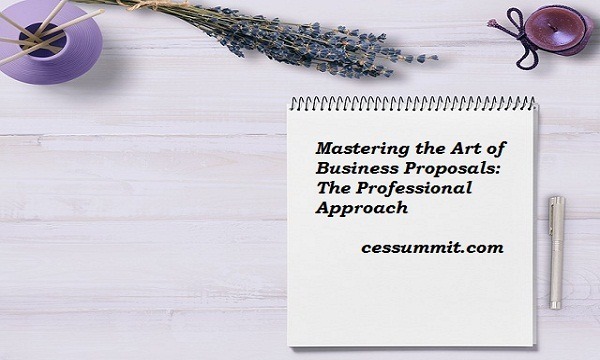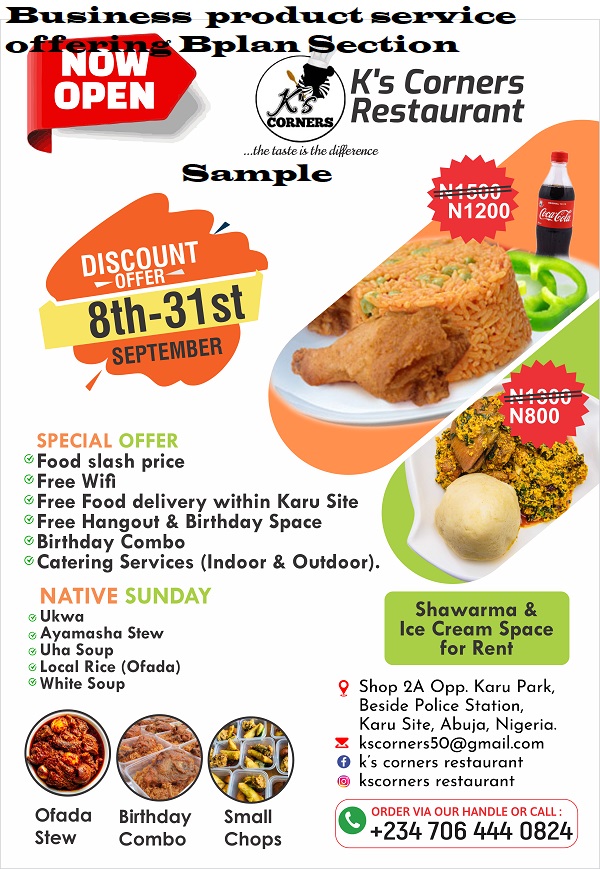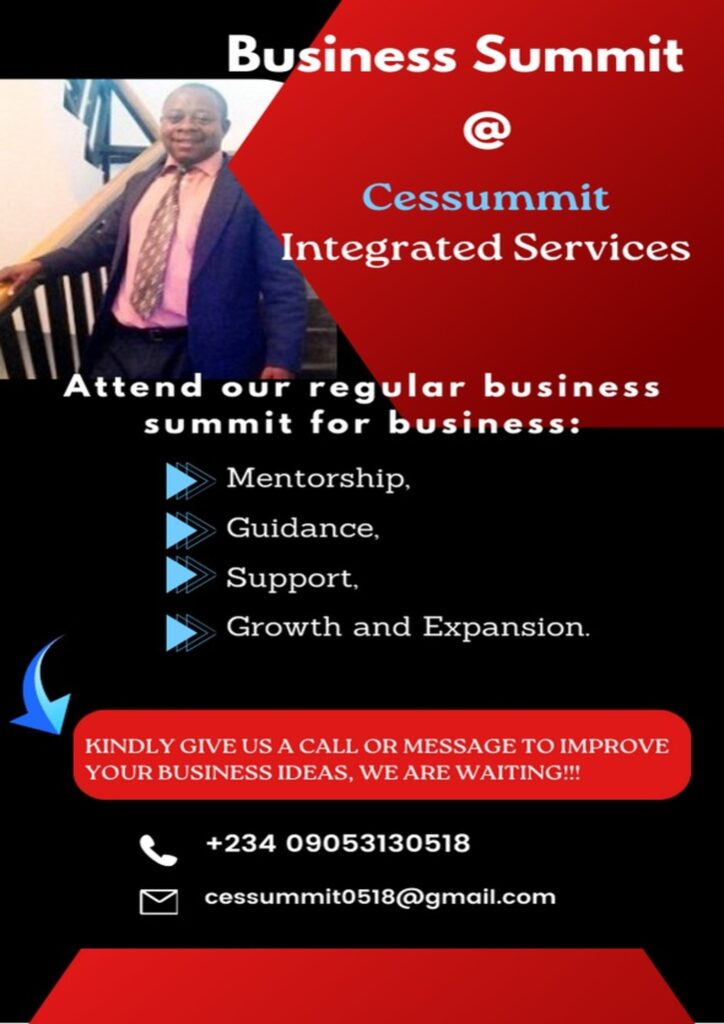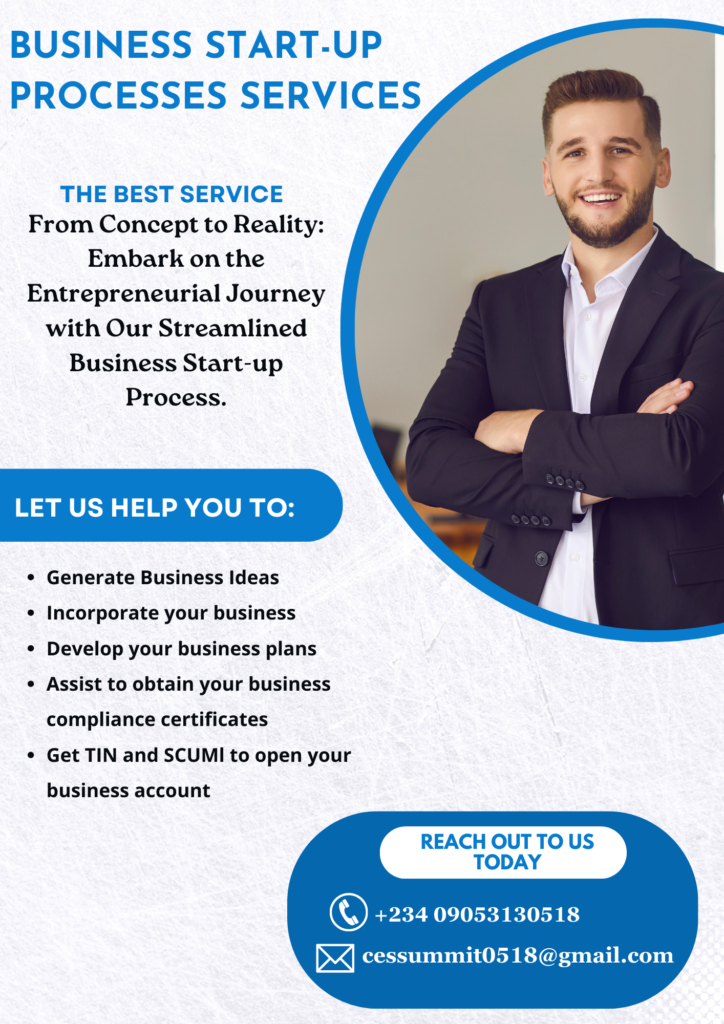
Mastering the Art of Business Proposals: The Professional Approach
Mastering the Art of Business Proposals: The Professional Approach – In today’s competitive business landscape, the ability to craft compelling and persuasive proposals is a skill that can set professionals apart from the crowd. Whether it’s securing a new client, presenting a project idea to stakeholders, or seeking funding for a venture, mastering the art of business proposals is crucial for success. A well-crafted proposal not only showcases your expertise and capabilities but also demonstrates a professional approach that instills confidence in potential partners and investors. By understanding the key elements, strategies, and best practices involved in creating effective business proposals, professionals can enhance their chances of achieving their objectives and thriving in the ever-evolving world of commerce.
Contents
- 1 The Focus of this Post:
- 2 Get Started:
- 2.1 Mastering the Art of Business Proposals: The Professional Approach
- 2.2 Mastering the Art of Business Proposals: The Professional Approach
- 2.3 Mastering the Art of Business Proposals: The Professional Approach
- 2.4 Mastering the Art of Business Proposals: The Professional Approach
- 2.5 Mastering the Art of Business Proposals: The Professional Approach
- 2.6 Mastering the Art of Business Proposals: The Professional Approach
- 2.7 Mastering the Art of Business Proposals: The Professional Approach
- 2.8 Mastering the Art of Business Proposals: The Professional Approach
- 2.9 Cessummit Business Development & Support Services:
- 2.10 Mastering the Art of Business Proposals: The Professional Approach
- 2.11 Read Also:
- 2.12 Finally: Mastering the Art of Business Proposals: The Professional Approach
- 2.13 Share this:
- 2.14 Like this:
The Focus of this Post:
The focus of this post is to discuss the need and importance of a business proposal. And, then teach you how to write it. So, go on reading.
What is Business Proposals?
A business proposal is a formal document that outlines a proposed project, product, or service to a potential client, investor, or partner. It serves as a means of communication and persuasion, presenting a comprehensive overview of the proposed solution, its benefits, and the associated costs. Business proposals are typically written in response to a request for proposal (RFP) or as a proactive initiative to initiate a business relationship.
A well-structured business proposal typically includes the following elements:
- Introduction: This section provides an overview of the proposal, introduces the proposing company or individual, and establishes the purpose and objectives of the proposal.
- Executive Summary: A concise summary of the proposal that highlights key points, including the problem statement, proposed solution, benefits, and expected outcomes.
- Problem Statement: Clearly defines the issue or challenge that the proposal aims to address. It should be framed in a way that highlights the pain points and emphasizes the need for a solution.
Mastering the Art of Business Proposals: The Professional Approach
- Proposed Solution: Describes the product, service, or project being offered as the solution to the identified problem. It should clearly explain how the proposed solution meets the needs of the client or target audience.
- Methodology and Approach: Outlines the specific strategies, methods, and resources that will be utilized to implement the proposed solution. This section demonstrates the proposer’s understanding of the task at hand and showcases their expertise.
- Timeline and Deliverables: Specifies the proposed timeline for project completion, as well as the key milestones and deliverables. This section helps the recipient assess the feasibility and practicality of the proposal.
- Budget and Pricing: Presents the financial aspects of the proposal, including the estimated costs, pricing structure, and payment terms. It should be clear, and transparent, and demonstrate value for the investment.
Mastering the Art of Business Proposals: The Professional Approach
- Company Overview and Credentials: Provides relevant information about the proposing company or individual, such as their background, experience, qualifications, and success stories. This section builds credibility and trust.
- Conclusion and Call to Action: Summarizes the key points of the proposal, reiterates the benefits, and encourages the recipient to take the desired action, whether it’s signing a contract, investing, or initiating further discussions.
Business proposals require careful consideration, research, and customization to cater to the specific needs and preferences of the intended audience. They should be well-written, visually appealing, and persuasive to increase the likelihood of securing a positive response.
Mastering the Art of Business Proposals: The Professional Approach
Why are Business Proposals important for a business?
Business proposals play a vital role in the success of a business for several reasons:
- Securing New Clients or Customers: Business proposals are often used to win new clients or customers. They allow businesses to present their products or services in a compelling and structured manner, highlighting their unique value propositions and addressing the specific needs of potential clients. A well-crafted proposal can differentiate a business from its competitors and increase the chances of winning new business opportunities.
- Building Trust and Credibility: A professional and well-designed business proposal demonstrates a business’s competence, expertise, and professionalism. It showcases the organization’s understanding of the client’s requirements, industry trends, and best practices. By presenting a detailed proposal that outlines the proposed solution and its benefits, businesses can establish trust and credibility with potential clients, partners, and investors.
- Clarifying Expectations: Business proposals provide a platform for both parties to align their expectations and clarify the scope, objectives, and deliverables of a project or collaboration. By clearly defining the project parameters, timelines, and responsibilities, proposals help minimize misunderstandings and disagreements down the line. This clarity fosters better collaboration and improves the overall project outcomes.
Mastering the Art of Business Proposals: The Professional Approach
- Obtaining Funding or Investment: Entrepreneurs and business owners often use business proposals to secure funding or investment for their ventures. A well-crafted proposal can effectively communicate the business idea, market potential, revenue projections, and return on investment. It helps convince investors or lenders of the viability and profitability of the business, increasing the likelihood of securing the necessary financial support.
- Strengthening Communication and Professionalism: Business proposals serve as a professional communication tool that helps businesses articulate their ideas, strategies, and solutions in a structured and coherent manner. They demonstrate professionalism, attention to detail, and a commitment to delivering quality outcomes. Proposals also serve as reference documents that can be shared among stakeholders, fostering effective communication and collaboration throughout the project lifecycle.
- Enhancing Competitive Advantage: In competitive industries, businesses often need to differentiate themselves from competitors to stand out. A well-crafted business proposal can showcase unique selling points, innovative approaches, and tailored solutions that give a business a competitive edge. By effectively communicating their value proposition, businesses can position themselves as the preferred choice for potential clients or partners.
In summary, business proposals are important for a business as they help secure new clients, build trust and credibility, clarify expectations, obtain funding, strengthen communication, and enhance competitive advantage. By investing time and effort in creating persuasive and well-structured proposals, businesses can increase their chances of success and growth in today’s competitive marketplace.

Mastering the Art of Business Proposals: The Professional Approach
Get Started:
I. Introduction
A. Importance of business proposals
- Business proposals are essential for securing new clients, partnerships, or funding.
- They serve as a road map for potential collaborations and projects.
- Well-crafted proposals increase the chances of success and showcase professionalism.
B. Purpose of the post
- The post aims to provide a comprehensive guide to mastering the art of business proposals.
- It will cover the key components, research and preparation, writing style, customization, presentation, and the review process.
Mastering the Art of Business Proposals: The Professional Approach
II. Understanding the Basics
A. Definition of a business proposal
- A business proposal is a formal document that outlines a proposed project, product, or service to a potential client or investor.
- It presents a problem, offers a solution, and explains the benefits and implementation plan.
B. Key components of a business proposal
- Executive summary: A concise overview of the proposal, highlighting its key points.
- Problem statement: Clearly define the issue or challenge the proposal aims to address.
- Proposed solution: Present a detailed solution that addresses the problem statement effectively.
- Implementation plan: Outline the steps, timeline, and resources required to execute the proposed solution.
- Budget and financial information: Provide a comprehensive breakdown of the costs and financial projections.
- Conclusion and next steps: Summarize the proposal and specify the desired action or response from the client.
Mastering the Art of Business Proposals: The Professional Approach
III. Research and Preparation
A. Know your audience
- Understand the client’s needs, preferences, and expectations.
- Research their industry, competitors, and market trends.
- Tailor the proposal to resonate with the client’s specific interests and pain points.
B. Conduct market research
- Gather data on market demand, target audience, and potential competitors.
- Identify unique selling points that differentiate your proposal from others.
- Use market research findings to support the feasibility and potential success of your proposal.
C. Identify the client’s needs and pain points
- Engage with the client to gather information about their challenges and desired outcomes.
- Align your proposal with their specific needs, demonstrating a clear understanding of their pain points.
D. Gather supporting data and evidence
- Collect relevant statistics, case studies, testimonials, or research findings to strengthen your proposal.
- Use credible sources to back up your claims and demonstrate the viability of your solution.
E. Set clear objectives and goals
- Define the objectives of your proposal, such as generating revenue, solving a problem, or expanding market reach.
- Ensure your goals are measurable, realistic, and aligned with the client’s expectations.
Mastering the Art of Business Proposals: The Professional Approach
IV. Crafting an Effective Business Proposal
A. Start with a compelling executive summary
- Summarize the key points of the proposal concisely and persuasively.
- Grab the reader’s attention and entice them to continue reading.
B. Clearly articulate the problem statement
- Describe the problem or challenge in detail, highlighting its impact on the client’s business or industry.
- Use relevant data or anecdotes to emphasize the significance of the problem.
C. Present a well-thought-out solution
- Outline your proposed solution, emphasizing its effectiveness and unique aspects.
- Clearly explain how the solution addresses the problem and meets the client’s needs.
Mastering the Art of Business Proposals: The Professional Approach
D. Outline a detailed implementation plan
- Break down the steps involved in implementing the proposed solution.
- Include a timeline, milestones, and allocated resources to provide a clear roadmap.
E. Provide a realistic budget and financial information
- Estimate the costs involved in implementing the solution accurately.
- Include a detailed breakdown of expenses and revenue projections.
- Show the potential return on investment (ROI) for the client.
F. Use visuals and graphics to enhance readability
- Incorporate visual elements such as charts, graphs, or infographics to present data and information in a visually appealing manner.
- Use images or diagrams to illustrate complex concepts or processes.
- Ensure that visuals are clear and relevant, and support the content of the proposal.
G. Include a call-to-action and the next steps
- Clearly state the desired action you want the client to take.
- Provide instructions for the next steps, such as scheduling a meeting or submitting a response.
- Encourage the client to reach out for further clarification or discussion.
Mastering the Art of Business Proposals: The Professional Approach
V. Writing Style and Formatting
A. Use a professional and concise writing style
- Write in a formal tone, using clear and concise language.
- Avoid jargon or technical terms that may confuse the reader.
- Proofread and edit for grammar, spelling, and punctuation errors.
B. Structure the proposal logically and coherently
- Organize the content in a logical flow, starting from the executive summary and progressing through each section.
- Use headings and subheadings to create a well-structured document.
- Ensure that there is a clear connection between different sections.
C. Pay attention to grammar, spelling, and punctuation
- Double-check for any grammatical, spelling, or punctuation errors.
- Use grammar and spell-check tools to enhance accuracy.
- Consider seeking the assistance of a proofreader or editor for a thorough review.
D. Format the proposal for easy reading
- Use a consistent font style and size throughout the document.
- Include sufficient white space, bullet points, and formatting elements to improve readability.
- Consider using bold or italicized text to highlight key points.
E. Include a table of contents and page numbers
- Create a table of contents at the beginning of the proposal to help the reader navigate through the document.
- Add page numbers to facilitate easy referencing.
Mastering the Art of Business Proposals: The Professional Approach
VI. Tailoring the Proposal to the Client
A. Customize the proposal to match the client’s needs
- Personalize the proposal by addressing the client by name and using their company information.
- Highlight specific challenges or pain points that are relevant to the client’s industry or situation.
B. Address the client’s pain points directly
- Show a deep understanding of the client’s challenges and explain how your solution directly addresses those pain points.
- Demonstrate empathy and offer insights into how the proposed solution will alleviate their concerns.
C. Highlight your unique selling points and competitive advantage
- Communicate the strengths and advantages of your proposal.
- Emphasize what sets you apart from competitors and why the client should choose your solution.
Mastering the Art of Business Proposals: The Professional Approach
D. Show understanding of the client’s industry and challenges
- Research the client’s industry thoroughly and demonstrate your knowledge of industry-specific trends, challenges, and opportunities.
- Discuss how your solution aligns with the client’s industry goals and requirements.
E. Use testimonials or case studies relevant to the client
- Include testimonials or case studies from previous clients that showcase successful implementations or positive outcomes.
- Highlight how similar businesses or organizations have benefited from your solution.

Mastering the Art of Business Proposals: The Professional Approach
VII. Presenting and Pitching the Proposal
A. Prepare for the presentation
- Rehearse your presentation to ensure a confident and polished delivery.
- Familiarize yourself with the content of the proposal and be prepared to answer questions.
B. Use visuals and slides effectively
- Create visually appealing slides that complement your presentation.
- Use images, graphs, or charts to support your key points.
- Keep the slides simple and uncluttered, focusing on the essential information.
C. Practice your delivery and anticipate questions
- Practice presenting the proposal to ensure a smooth and engaging delivery.
- Anticipate potential questions or concerns the audience may have and prepare thoughtful responses.
D. Engage the audience and address concerns
- Maintain eye contact and use confident body language to engage the audience.
- Address any concerns or objections raised during the presentation with well-prepared responses.
- Listen actively to the audience’s feedback and be open to discussion.
E. Follow up after the presentation
- Send a follow-up email or communication to thank the audience for their time.
- Provide any additional information or clarification requested during the presentation.
- Keep the lines of communication open for further discussion or negotiation.
Mastering the Art of Business Proposals: The Professional Approach
VIII. Reviewing and Iterating
A. Seek feedback from colleagues or mentors
- Share your proposal with trusted colleagues or mentors and seek their feedback.
- Consider their perspectives and suggestions for improvement.
B. Analyze the proposal’s strengths and weaknesses
- Conduct a thorough review of the proposal, identifying its strengths and weaknesses.
- Assess the clarity of the message, the persuasiveness of the arguments, and the overall effectiveness.
C. Revise and refine the proposal as needed
- Incorporate feedback and make necessary revisions to enhance the proposal’s quality.
- Ensure that the proposal remains aligned with the client’s needs and expectations.
D. Update the proposal with current information
- Regularly update the proposal with the latest market research, case studies, or relevant data.
- Keep the content fresh and up-to-date to maintain its relevance and credibility.
Mastering the Art of Business Proposals: The Professional Approach
Cessummit Business Development & Support Services:
Cessummit is a premier provider of comprehensive Business Development & Support Services, catering to the needs of both start-ups and existing businesses. We understand the challenges faced by entrepreneurs and organizations at various stages of their growth journey, and we are committed to helping them achieve their goals and maximize their potential.
Our range of services encompasses a wide spectrum of business areas, designed to address the specific needs and requirements of our clients. Whether you are a start-up looking to establish your presence in the market or an established business aiming to expand your operations, our team of experienced professionals is equipped to provide tailored solutions to meet your unique needs.
Here are some key services that we offer:
- Market Research and Analysis: We conduct thorough market research and analysis to provide valuable insights into industry trends, customer behavior, and competitive landscapes. This information enables our clients to make informed business decisions and develop effective strategies.
- Business Planning and Strategy: We assist in developing comprehensive business plans and strategies that outline clear objectives, identify target markets, and define actionable steps to achieve sustainable growth. Our expertise in strategic planning ensures that our clients have a solid foundation for success.
Mastering the Art of Business Proposals: The Professional Approach
- Financial Consulting: We provide financial consulting services, including budgeting, financial forecasting, and investment analysis. Our team helps clients optimize their financial resources, manage cash flow effectively, and explore funding opportunities to support their business goals.
- Marketing and Branding: Our marketing and branding services are tailored to enhance brand visibility, attract customers, and generate leads. We develop effective marketing campaigns, create compelling content, and utilize digital marketing strategies to boost our clients’ online presence.
- Sales and Business Development: We offer sales and business development support to help our clients generate revenue and expand their customer base. Our team assists in identifying new business opportunities, establishing strategic partnerships, and implementing sales strategies to drive growth.
- Operational Support: We provide operational support services to streamline business processes and improve efficiency. From optimizing supply chains to implementing technology solutions, we offer practical guidance and expertise to enhance overall operational performance.
At Cessummit, we are dedicated to fostering the success of our clients. We understand that each business is unique, and we tailor our services to meet individual requirements. Our team is committed to delivering high-quality solutions, backed by industry knowledge and experience.
Mastering the Art of Business Proposals: The Professional Approach
To learn more about how Cessummit can assist your business, please feel free to reach out to us at cessummit0518@gmail.com or contact us at 09053130518. Our team is ready to discuss your needs and provide personalized assistance to help you achieve your business objectives.

Mastering the Art of Business Proposals: The Professional Approach
Read Also:
- How to Write Winning Proposals that Close Deals
- The Importance of Time Management in Completing Class Assignments
- Learn how to write your Business Profile
- How to Raise Funds for Your Project by Crowdfunding
- This is How Crowdfunding is Revolutionizing Entrepreneurship
- Tips for Managing Multiple Class Assignments as a Student
- Secrets of Growth Hacking: Tips and Tricks from Successful Entrepreneurs
- Cessummit.com Services Offerings: What we do & How
- Profitable Business Ideas
Finally: Mastering the Art of Business Proposals: The Professional Approach
In conclusion, on Mastering the Art of Business Proposals: The Professional Approach, mastering the art of business proposals is essential for success in the professional world. By adopting a professional approach, individuals can significantly enhance their chances of securing new opportunities, winning contracts, and achieving their business goals. Remember to thoroughly research your audience, clearly articulate your value proposition, provide evidence of your capabilities, and showcase your professionalism in every aspect of your proposal. With practice and continuous improvement, you can become a master at crafting compelling business proposals that leave a lasting impression and open doors to exciting possibilities. So, embrace the art, refine your skills, and watch as your business proposals pave the way to success.






